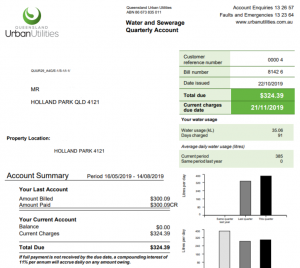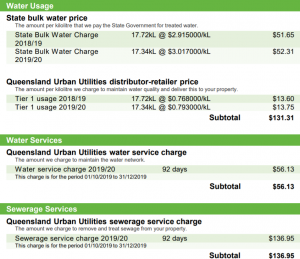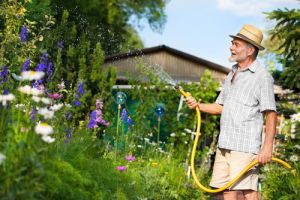Queenslanders know a thing or two about water. Whether it’s running through garden sprinklers as children or opening those dreaded bills as adults, you simply can’t escape H2O in the Sunshine State. Although it’s easy to take water for granted sometimes, reality usually sinks in when the time comes to pay for it. But just how much does it cost? In this guide, we outline the price of water in Brisbane and its surrounds, plus list a few helpful details on water rates and bills.
Jump to:
- Understanding water bill charges
- Water rates in Brisbane
- Water rates in SEQ
- How to read your water bill
- How often do water rates change?
- Sewerage and other charges
Understanding water bill charges
Water bills can be broken down into two main components – usage and supply charges – but it’s not as simple as it sounds. Please keep in mind that the charges below refer to a Brisbane water bill from Queensland Urban Utilities, and depending on where you live, certain charges may be listed under different names.
- Water usage charges: Consists of two parts; state bulk water price and distributor-retailer price. State bulk water price refers to the amount per kilolitre that your retailer pays the State Government for treated water, while the distributor-retailer price is the amount per kilolitre your retailer charges to maintain water quality and deliver it to your home.
- Fixed water supply charge: This is a set charge that covers your retailer to maintain the water network. It may be charged daily, quarterly or yearly, depending on which region you live in. In some areas, water service charges will vary depending on the size of each meter servicing each lot on a property. A 20mm meter is standard on most residential properties.
How much are water rates in Brisbane?
Here are the water prices for residential customers in Brisbane. These rates are set by Queensland Urban Utilities, a distributor-retailer responsible for delivering water to your property.
| Council | State bulk water price (per kilolitre) | Distributor-retailer price (per kilolitre) | Water service charge |
| Brisbane | $3.122 | $0.793 (up to 74kL per quarter) $1.569 (over 74kL per quarter) |
$56.13 per quarter |
| Ipswich | $3.122 | $0.933 (up to 74kL per quarter) $1.589 (over 74kL per quarter) |
$80.61 per quarter |
| Lockyer Valley | $3.122 | $0.642 (up to 822 litres per day) $1.589 (over 822 litres per day) |
$0.883 per day or $0.662 per day for low pressure |
| Scenic Rim | $3.122 | $0.933 (up to 74kL per quarter) $1.589 (over 74kL per quarter) |
$80.61 per quarter |
| Somerset | $3.122 | $0.642 (up to 822 litres per day) $1.346 (over 822 litres per day) |
$0.883 per day |
Source: Queensland Urban Utilities, Water and Sewerage Charges 2020-21
What about other areas in south east QLD?
Here are the water rates for residential customers in SEQ. These prices are set by each area’s respective distributor-retailer.
| Council | State bulk water price (per kilolitre) | Distributor-retailer price (per kilolitre) | Water service charge |
| Gold Coast | $3.122 | $1.090 | $0.5810 per day |
| Logan | $3.122 | $1.0224 | $74.80 per quarter |
| Moreton Bay | $3.122 | $0.667 (up to 822 litres per day) $1.333 (over 822 litres per day) |
$0.879 per day |
| Noosa | $3.122 | $0.667 (up to 822 litres per day) $1.333 (over 822 litres per day) |
$0.718 per day |
| Redland | $3.122 | $0.614 | From $70.12 per quarter |
| Sunshine Coast | $3.122 | $0.667 (up to 822 litres per day) $1.333 (over 822 litres per day) |
$0.718 per day |
Please refer to each respective council website. Some prices may vary depending on the size of a property. Accurate as of 2020-21.
How to read your water bill in Brisbane
While no two water bills are the same, we’ll run you through an example of a bill you’d likely come across in Brisbane from Queensland Urban Utilities. The screenshot below is the first page of a water bill, listing information such as the supply address, bill number, customer reference number, total bill amount and due date.

Next is the second page of the water bill, detailing a breakdown of charges relevant to a specific billing period. In this case, it’s 92 days or a quarter. You’ll notice the two usage charges (state bulk water price and distributor-retailer price) as well as the fixed water service charge beneath. Lastly, you’ll see a charge for sewerage services, which is a cost for removing and treating sewage from your property. We’ll discuss sewerage in detail a little further down.

How often do water rates change in Brisbane?
In Brisbane, water rates change every year, typically from July 1, but the rates you’re charged will depend on when your water meter was last read. This means you may see two different rates on the two usage portions of your bill. For example, in 2018-19 the water access charge for Brisbane was $54.12, while in 2019-20 this charge increased to $56.13. Water usage rates have also increased over this period.
How frequent are water bills in Brisbane?
Customers will usually receive a water bill every three months, or have a billing period of between 85 and 95 days. The date a customer receives their water bill will depend on when their last meter reading was carried out by their distributor-retailer. In some areas of south east Queensland, billing cycles may take place more frequently, or every six months.
What is a kilolitre (1kL)?
One kilolitre refers to 1,000 litres of water, which is equal to 50 standard dishwasher cycles. As no two houses are the same, it’s best to check your water consumption each quarter to make sure you’re not unknowingly wasting water. Water usage is normally listed on the second page of your bill. See below as an example from Queensland Urban Utilities.

Sewerage and other charges in water bills
Aside from water usage and supply charges, water bills will consist of a sewerage fee. This is included in the overall water bill and is generally listed as ‘sewerage services’ or ‘waste charge’. Other charges may include connection or disconnection fees, while some businesses may incur a trade waste fee.
Is water included in rates in QLD?

No, water is billed separately to rates in Brisbane and south east Queensland. Rates are issued from a region’s respective council (e.g. Ipswich City Council), while water bills are the responsibility of an area’s distributor-retailer (e.g. Queensland Urban Utilities). Keep in mind that in some regions, such as Gold Coast and Logan, the local council is in charge of water billing.
Why is my water bill so high?
Before jumping to conclusions, it’s best to check your water usage habits during the billing period. You may find that water is consumed more in the warmer months, like watering your gardens or entertaining more frequently. It’s seasonal changes like these that make a big difference to your costs. Also, check to see that there are no leaks at your property, as a water leakage can easily increase overall costs.
If you believe there’s been a mistake, you can always read your meter or get in direct contact with the water company. As no two houses use the same amount of water, it’s difficult to give a direct comparison. You can, however, refer to your bill, which may list the average water consumption in your area, making it easier to see where you stand.
Image credits: Smolina Marianna/Shutterstock.com, Queensland Urban Utilities, Alexander Raths/Shutterstock.com


Share this article